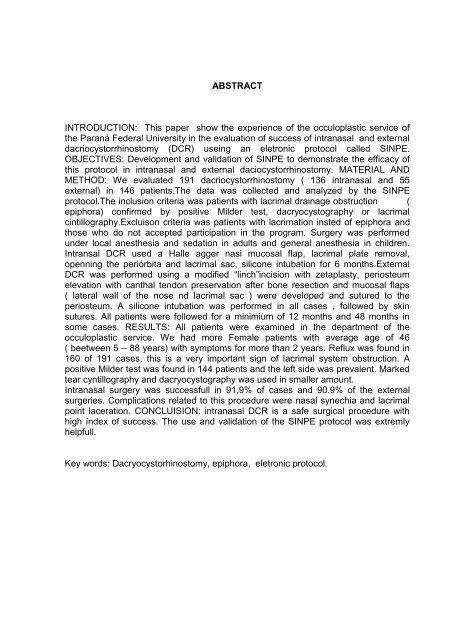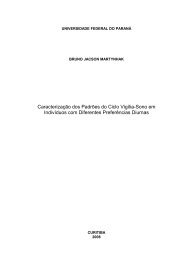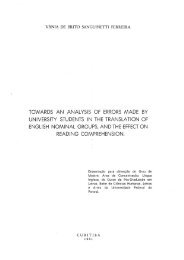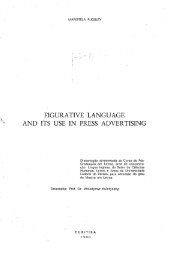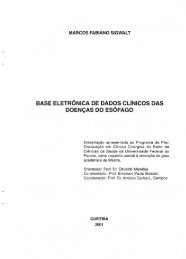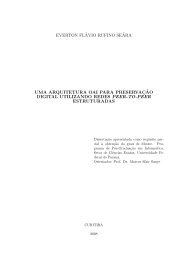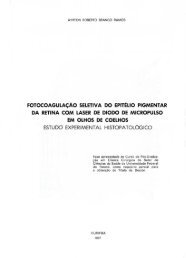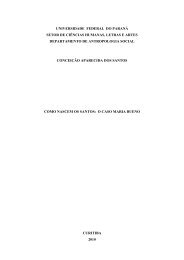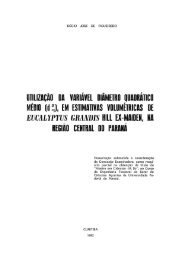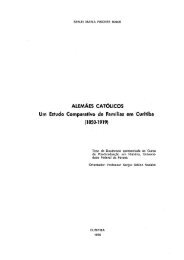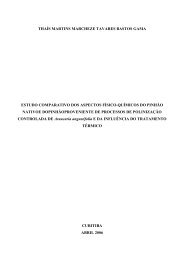Dissertacao Dr. Fabio Maniglia.pdf - Universidade Federal do Paraná
Dissertacao Dr. Fabio Maniglia.pdf - Universidade Federal do Paraná
Dissertacao Dr. Fabio Maniglia.pdf - Universidade Federal do Paraná
Create successful ePaper yourself
Turn your PDF publications into a flip-book with our unique Google optimized e-Paper software.
ABSTRACT<br />
INTRODUCTION: This paper show the experience of the occuloplastic service of<br />
the <strong>Paraná</strong> <strong>Federal</strong> University in the evaluation of success of intranasal and external<br />
dacriocystorrhinostomy (DCR) useing an eletronic protocol called SINPE.<br />
OBJECTIVES: Development and validation of SINPE to demonstrate the efficacy of<br />
this protocol in intranasal and external daciocystorrhinostomy. MATERIAL AND<br />
METHOD: We evaluated 191 dacriocystorrhinostomy ( 136 intranasal and 55<br />
external) in 146 patients.The data was collected and analyzed by the SINPE<br />
protocol.The inclusion criteria was patients with lacrimal drainage obstruction (<br />
epiphora) confirmed by positive Milder test, dacryocystography or lacrimal<br />
cintillography.Excluison criteria was patients with lacrimation insted of epiphora and<br />
those who <strong>do</strong> not accepted participation in the program. Surgery was performed<br />
under local anesthesia and sedation in adults and general anesthesia in children.<br />
Intransal DCR used a Halle agger nasi mucosal flap, lacrimal plate removal,<br />
openning the periórbita and lacrimal sac, silicone intubation for 6 months.External<br />
DCR was performed using a modified “linch”incision with zetaplasty, periosteum<br />
elevation with canthal ten<strong>do</strong>n preservation after bone resection and mucosal flaps<br />
( lateral wall of the nose nd lacrimal sac ) were developed and sutured to the<br />
periosteum. A silicone intubation was performed in all cases , followed by skin<br />
sutures. All patients were followed for a minimium of 12 months and 48 months in<br />
some cases. RESULTS: All patients were examined in the department of the<br />
occuloplastic service. We had more Female patients with average age of 46<br />
( beetween 5 – 88 years) with symptoms for more than 2 years. Reflux was found in<br />
160 of 191 cases, this is a very important sign of lacrimal system obstruction. A<br />
positive Milder test was found in 144 patients and the left side was prevalent. Marked<br />
tear cyntillography and dacryocystography was used in smaller amount.<br />
Intranasal surgery was successfull in 91,9% of cases and 90.9% of the external<br />
surgeries. Complications related to this procedure were nasal synechia and lacrimal<br />
point laceration. CONCLUISION: intranasal DCR is a safe surgical procedure with<br />
high índex of success. The use and validation of the SINPE protocol was extremly<br />
helpfull.<br />
Key words: Dacryocystorhinostomy, epiphora, eletronic protocol.


